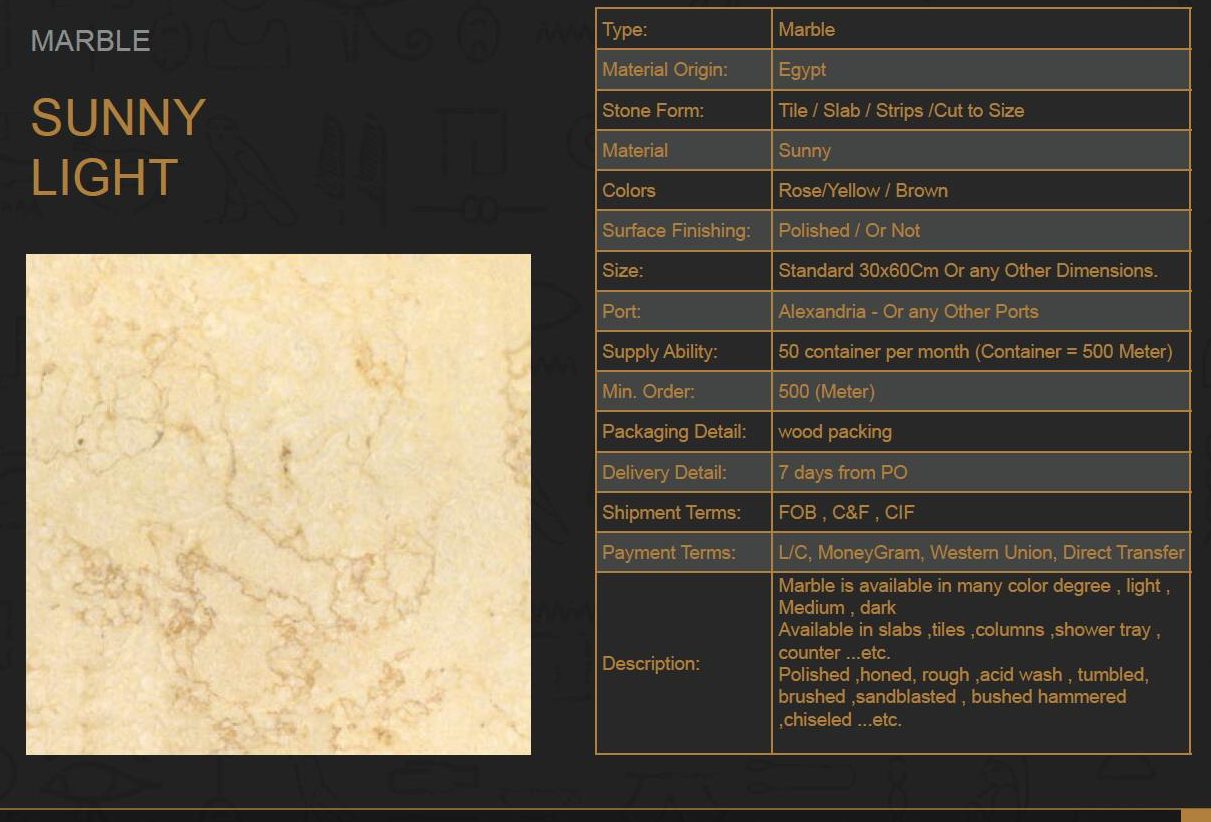Sunny Menia is distinguished by its high quality and different colours at Egypt
It is a kind of metamorphic rock made of recrystallized calcite or dolomite. Metaphoric rocks mean the rocks that are transformed over the years from the existing rocks. The process is known as metamorphism, which means a gradual changes in the form. Foliation is the repetitive layering process in the metamorphic rocks. According, to the studies in Geology, marble is not a foliated rock but there are many contradictions to this theory. Sunny marble is used in sculpturing and in the building process.
It is mainly used in floors, stairs, and external facades of buildings. This marble is considered one of the most famous Egyptian types.
There are many types of natural marble in Egypt, as it is formed as a result of the hardening process of lava in ancient times, due to the intense temperature and high pressure in the interior of the globe.
Egyptian marble is characterized by its continuous availability in the global market, as well as by its low price, which is commensurate with all classes.
Sunny Menia Orders:
Standard & cut to size tiles with rough surface finish
Standard & cut to size tiles with polished surface finish
Standard & cut to size tiles with brushed surface finish
Standard & cut to size tiles with bush hammered surface finish
All that is available in different thickness 1-10 cm
Sunny Advantages:
• Crushed marble is used for acid neutralization in rivers, lakes, soils, and ponds.
• It is used as an inert filler in pills
• Used in making sculptures and ornaments
• Powered marble is used in calcium addictive feeds.
Sunny Disadvantages:
• Using acid causes the marble to lose its luster and shine.
• It requires extra care and maintenance.
• It can be very cold during winters.
Distinctive properties for Sunny marbles:
• Marble rocks are denser, harder, and colorful than the original stone due to years of metamorphosis
• The veining is a distinctive feature of marble. Theses glistening veins are patterns made by the minerals that fill the cracks in the limestone.
• The shades of the marble depend on the region they originate from the climatic and soil conditions differ from place to place.
• Marble does not heat up quickly and does not absorb heat energy when compared to other materials like concrete and wood.
Effect of atmosphere on Sunny marble:
• The atmospheric gases combined with the rain can deteriorate the marble.
• It decays the structure of the rock and causes the dissolution of marble.
• Snow, rain, and temperature are also responsible for generating the movement of saltwater in the cracks.
• Temperature rise can increase the chemical change in marble and wind may cause erosion in marbles
Problem for Menia:
Weathering effects and thermal change can affect the durability of the rock substantially.
Due to its porosity, it does not absorb much water, but solubility of acid can affect the marble
Descriptions of Sunny Marble (Egyptian marble): –
Sunny colour: beige marble
Kind: Natural Stone
Marble quarry origin: Egyptian marble quarry | Egypt
Material availability: Blocks, slabs, tiles
Dimensions of the slabs: 265-300cm x 160-195cm
Thickness of the slabs (Availability): Thickness:1, 1.2, 1.5, 2, 3 CM
Dimensions of the marble tiles (Availability): Any dimensions
Thickness of the marble tiles for floors or walls: 15-20-30-40mm (up to 200mm by order)
Surface finishes: Polished, Saw-cut, honed, brushed, acid, sandblasted, bush-hammered, tumbled, striped, split Face marble tiles
Standard Specifications & Technical Data: –
Water Absorption (ASTM C 97): 0.29 %
Modulus of Rupture (ASTM C 99): 2 000 psi
Compressive Strength (ASTM C 170): 13 300 psi
Abrasion Resistance (ASTM C 24): 26.4 Ha
Flexural Strength (ASTM C 880): 1 600 psi
Density (ASTM C 97): 2 618

